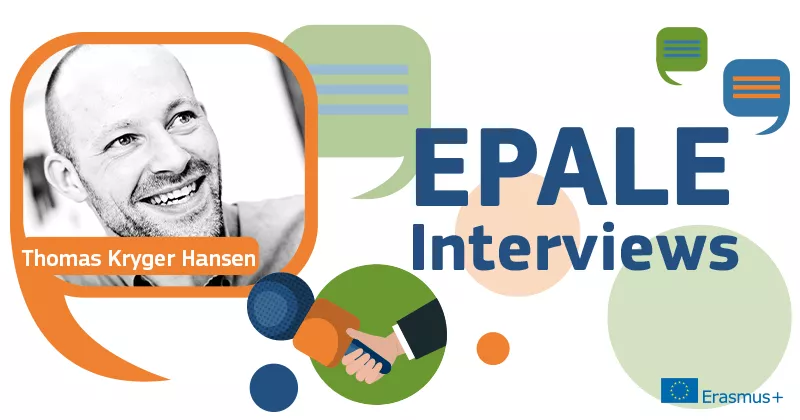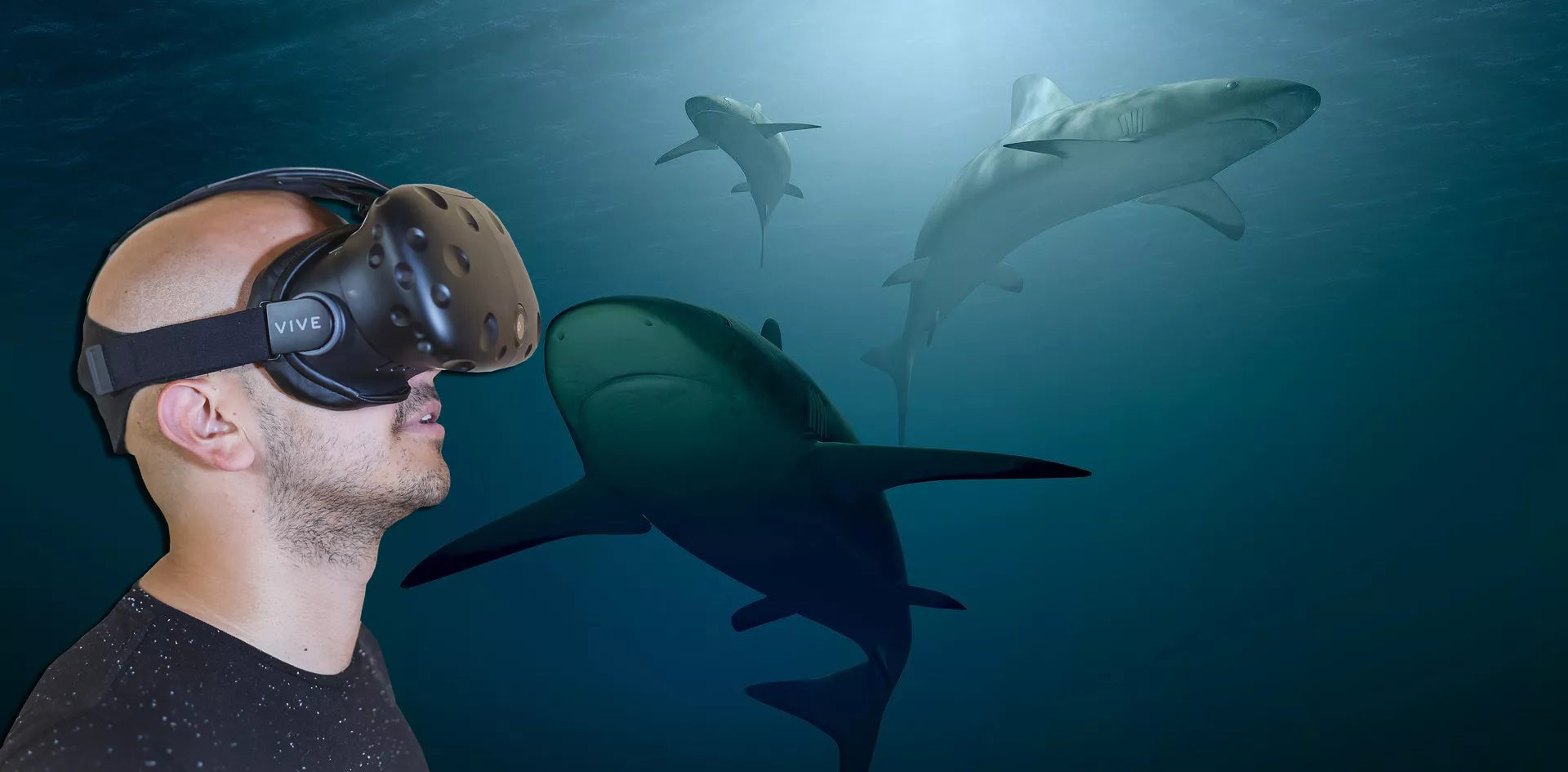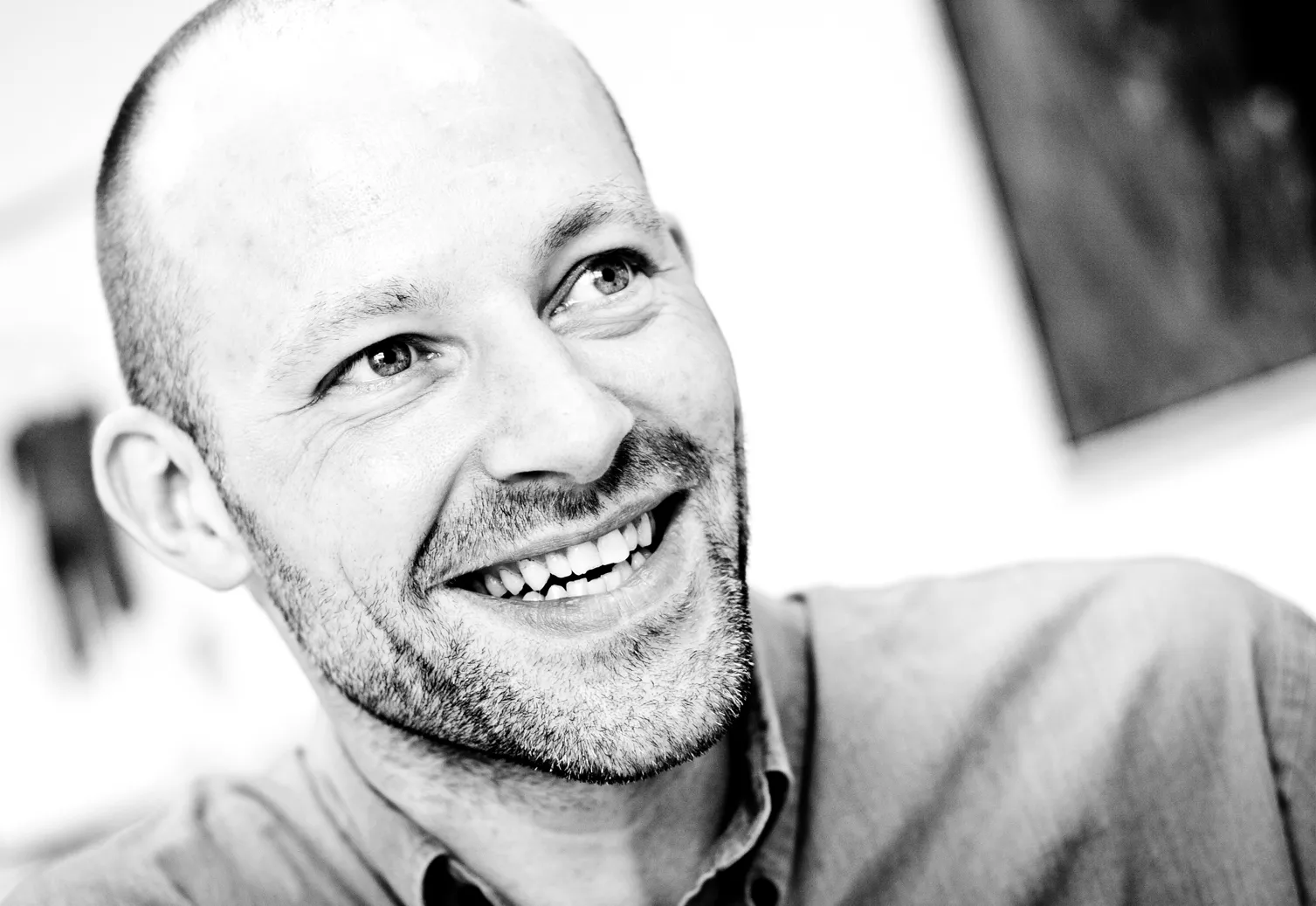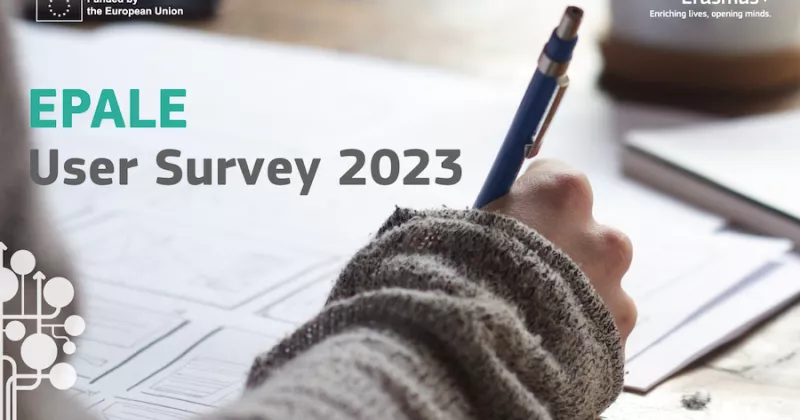What can virtual reality offer that real reality cannot?

Reading time approximately 15 minutes - Read, like, comment!
This contribution was originally published in German by Katrin Echtermeyer.
.
The view of a VR expert on virtual worlds in (adult) education
.
There is still something rather futuristic about putting on VR glasses and diving into another world, into a virtual adventure. Few people probably think of it as an educational adventure - and yet there are already a number of projects in adult education that use 3D modelling and 360° videos. What is the potential, today and in the future? Where are the limits?
An interview with Thomas K. Hansen, coordinator of several European VR projects, about his fascination with virtual worlds, his vision of future learning and his distrust of people who want to hold his backpack...
.
Do you remember your first own VR experience? When, where, what was it?
I would actually claim that I had two first times. My first first time: London, 1993. I am walking down Oxford Street, having just moved to England after finishing high school, and looking out for work. I walk by an arcade and see a giant contraption that I haven’t seen before. The guy next to me sees me - he is apparently some sort of instructor – and quickly explains to me that it’s “virtual reality” and I can put on the helmet and participate in a real tank battle. “Give me your backpack and put on the helmet if you want to try,” he says. I look at him with an “I have no idea who you are and I’m not going to give you my backpack and put on something that prevents me from seeing you” look. I end up doing it anyway and climb into the machine, put on the helmet and it’s pretty cool to be able to look around. Although it takes a little time getting used to it. The shooting physics are a little off, the helmet is heavy and the world is very pixelated, so the visuals aren’t that fantastic. And I’m still a little concerned for my backpack. It was a brief, but interesting experience, which I obviously didn’t forget afterwards.

Fast forward, Vejle Municipality, 2016. The Game Engine Company Unity has established an office in Vejle, set up a VR room and invited me and some other guys, because they want to promote Unity as the favourite VR engine for developers. So, we try an HTC Vive. They put me into the “The Blu” experience, and set me on the deck of a sunken ship, with myriads of fish. Glorious underwater sounds in my ears and stingrays when I look up, and I see the beautiful reflection of the sun in the surface. Having worked as a diver and dive instructor for so many years, the experience still takes my breath away - although I do keep thinking: Why am I not wet? A whale sound rises, I look around, and that enormous, fantastic beast swims by, so close to me …. The whale holds still, looks at me with one eye – then slaps its enormous tail, which makes me move away so I won’t get hit by it. It’s marvellous, it’s brilliant – I completely believe in it and I really, really want to stay there longer.
.
In your story about the virtual encounter with the whale it's already discernible, but can you describe in general what the fascination of VR is?
The fascination is found within that strange word ”immersiveness” – and also finding out how easy it really is to cheat our very smart brain. I usually say that VR can do three things:
- It can take you places you might not otherwise be able to go. I’ve been to Mount Everest in a helicopter, which isn’t likely to happen.
- It can show you things you might not be able to see. I’ve travelled through a human heart and seen all the small workings of that amazing organ.
- It can let you try things you might not otherwise be able to try. I recently tried Felix Baumgartner’s leap from 40+ kilometers into space and I’ve driven a Formula 1 car not long ago.
And because of this feeling of “immersiveness”, the fact that you are surrounded, enveloped by this amazing environment, your brain just subscribes to the experience and sends all the right neurological signals to the right nerves and makes you believe that you are in fact right there. I’ve seen grown men screaming for their lives because they were attacked by zombies, and psychologists who couldn’t manage to walk out onto a “plank” from the top of a tall building, because they were scared of heights, even though in reality they were standing on the floor in their office…. It’s amazing.
.
When did you see a chance or possibility for the first time to "include" your fascination for VR into your work? What was it about?
My fascination after the Unity arrangement was simply peaked to a new height. I don’t think I actually “saw” an opportunity to integrate VR in what we were doing, so I had to create one. Step 1 here was getting my hands on some gear, which is not something that a municipality really has extra money for. But I managed to wring out a little bit of cash from an executive and we bought our first HTC Vive platform. Then we discovered that the Center for Special Education for Adults had long wanted to develop some sort of training environment for people who had been struck by a blood clot, brain haemorrhage, or similar. So, we designed a VR supermarket environment around that topic. We started fund-raising, and the municipality thought the idea was so great that they decided to give us a guarantee, that if we didn’t get any money, as long as we kept a certain low budget, then they would fund it. Today that environment is knows as CSV Cognition.
.
Did I understand it correctly that the target group - after the "damage" in the brain structure - in this supermarket environment should "learn" again how to buy groceries?
Actually, the supermarket itself was just an „environment“, in which to practice „methodologies“. The players were taught strategies by the therapists on what to do whenever they lost concentration. Things like: stop – breathe – think about where you are and what to do – act according to the plan.
In the supermarket, we gave them a shopping list they would have to purchase. Along the way we put disturbances in their way, like louder music or an aisle that was suddenly blocked, so they had to rethink their strategies. The therapists can influence the environment in real-time, by “nudging” them if they get stuck. For instance, by calling a „stop-breathe-think“ announcement over the loudspeakers.
.
Where do you see the special possibilities of VR for teaching and learning, especially in adult education?
I think my approach here is probably „where don’t I see it?“ It’s already being implemented in language teaching and vocational education, where training environments for all sorts of job types are being constructed all the way from carpentry to medicine and space exploration, job interviews, etc. Anywhere where any kind of visualization is relevant.
But, I’m not a fan of using VR just to use VR – if I were to narrow it down just a bit, then I’m a fan of Guido Makransky, a Danish researcher at Copenhagen University, who says that VR should be used when reality is:
- impossible, or
- too dangerous, or
- too expensive.
We should always ask: What is the added value of using VR? Does it make sense in this context? But, there is so much promise there. Instead of being in school learning Swahili, you travel to and explore Tanzania in VR, while interacting with the locals, learning the language, the culture….etc… It’s the Star Trek Holodeck. It can be everything.
.
Where are the limits of VR environments for teaching and learning? Where do you see weaknesses?
Where are the limits of the VR environments… I’m a little hesitant here, maybe not having thought enough about it just yet, and therefore trivializing it a bit – but I don’t think there are limitations to the environments. We can create and visualize anything we want in the environments. I think the limitations are set by the VR hardware, which would include for instance:
- We can’t touch in VR, like shake hands for instance. But this is quickly changing due to haptic gloves;
- Verbal interaction is limited due to limitations of microphone quality and quality of speech recognition;
- Locomotion and ensuing “motion sickness”;
- We have to accept a trade-off in quality vs mobility, meaning we need tethered headsets for optimal graphical quality, and need to lower our demands regarding graphic quality if we want a “carry-around-headset,” Moore’s law predicts that it won’t be long before we will have super-powered headsets without tethering.
Ah, it dawns on me that there is, at least, one non-hardware related issue, which is probably more pedagogical in nature than anything else. We must not be seduced by the allure of VR and think that learning will just take place. There is an enormous wow-factor to VR, which often times hides the fact that especially new learners don’t really acquire, or remember, the things they have just gone through. They have just been wowed. So, the message being that a sound pedagogy has to underline the VR otherwise it’s just another piece of tech. But, if the pedagogy is sound, then VR has a learning potential that will outperform anything else.
.
A look into the sewing box – it's probably only a German expression ... for "Let's talk about the little secret details"…: What are the particularly exciting, challenging, tricky moments in the implementation of a VR project? Can you tell us a funny episode from the edge of development?
Hehe, inside the sewing box … nice expression. We tend, in our 3D modelling work, to mostly recreate actual places. One of the most fantastic things about the development process is seeing those places come to life, then put on the mask, find yourself in that environment, be able to actually look around, interact with people and objects, etc. The hardest thing, since we can’t make an actual photorealistic copy, is making it “real enough,” to make it believable.
There are two stories. They are not exclusive to VR, but relate to 3D development in general. The first one is always a “concern” of mine. Developers love Easter Eggs, which basically means, they like to “hide” weird things inside the environments. This means that all of a sudden you might find Darth Vader engraved on a tomb stone, or a picture of the millennium falcon somewhere…. Always completely inappropriate and has me concerned about copy rights.
The second story was our lead graphics developer. After having recreated the Train Station in Vienna a few years ago, he and I went there by train arriving in the evening. When we approached he was so overly excited and childishly giddy because he would finally get to see the thing he had been working on for so long. I’m glad the windows in the train couldn’t open – he would fall out leaning out of the window.
.
Thinking into the future and visionary – free from institutional, financial or other constraints – which project would you like to (co-)develop? VR and adult education should be included ...
Oh, the magic of no monetary and visionary boundaries!
My hope is that on the hardware front, someone will develop the Star Trek holodeck, so that we are freed from head mounted displays, hand-held controllers and similar.
My personal vision and ambition – I am a language and culture guy. But not necessarily a contemporary one. My vision is “The World of Learning.” Imagine Hunt for Europe (an Erasmus+ project for learning languages and culture through gaming) for all languages, in virtual reality, for all ages, where you join the game, and choose what language you want to learn, but also during which time period? Are you interested in Japanese during the Ming-dynasty? Then, that’s where you go. Do you have friends that you want to go explore the French Revolution with? Then, that’s what you do. See London during World War II, experience a speech by Churchill. All in a gamified environment that presents you with missions and objectives where you have to use your linguistic and cultural knowledge, perhaps integrated with your historical knowledge – Visit George Washington in the Valley Forge winter camp during the 1770’ies and on, and on and on….
It could be used for all ages, at all levels of education….I think it would be marvelous…..
.
Who can and should dare to offer their adult learners a virtual world? What are the essential questions, the milestones for the development of virtual (learning) environments?
Being a technology evangelist it would be easy to say that everybody should dare to offer it because most should – keeping in mind the criteria of being impossible, too expensive, too dangerous, etc. But I think currently we see a very classical trend, the horizontal outside in approach, where developers are trying to horizontally push VR into a „system.“ Enthusiasts are then the ones picking up bits and pieces, experimenting, implementing, lacking backup, encouragement and leadership/peer support and then slowly it dissipates again, because it becomes an addition to everything else that the promoter is doing and not an integral part of the routine.
So, what I am trying to say with that is that the milestones for VR development here are probably more related to making VR training/teaching a mandatory or integrated tool in the education sector. That also means that a core of standard environments should be available for teachers to use, the hardware should be available at the institutions and the teachers or trainers should, as part of their standard education, be made aware of and comfortable with VR as a medium and as a training tool.
So, that’s the vertical line of thinking, where I’d much prefer the bottom-up approach: make VR as a teaching medium a course in teacher and trainer education; develop a set of standard materials – designed by teachers, which will change of course, because that’s also what technology does.
In other words, VR needs to be politicized. I think you were asking for a different milestone, but this is actually the most important one to me if the potential is to be exploited.
:
You are right, it was not exactly what I had in mind when I asked for milestones. But of course it is a very interesting and absolutely important thought!
What does it mean in reverse for VR applications that are currently being developed in projects? Aren't they always "horizontal approaches"? How do you deal with this in your projects?
| On the diffusion of technology and customer segments |
 |
| .Source: on Digital Marketing |
.
.
I like the graph below which shows the rate of adoption of new technologies and by whom – it’s very telling to me. My idea here is that the horizontal approach captures all the raving enthusiasts. But at some point, if those enthusiasts don’t find support, the interest wanes and the tool just dies (blue line). But, as the yellow line indicates to me, if we can simultaneously work the vertical approach, then we can hopefully sustain the drive. This is the part that has always been the most difficult for me. Either because I’m not very good at it, or because I’ve had too little time to focus on the vertical approach.
...
.
.
.
.
.
Or how you said before: It's a political thing as well - or probably mostly. To establish a technology in or as teaching and learning environments in a sustainable way, is definitely a question of power and influence at the "system". But it could be easier if there are examples of good practices. By the way ... what are your current projects?
I think the biggest EU project, which might also be of common interest, we are getting close to finishing is WorkVR - a work oriented language and culture learning experience, with an e-learning section coupled with 4 Virtual Reality practice environments:
- a job interview;
- an elderly home where you can work in health-care;
- a construction site where you work in construction; and
- a hotel, where you can try and work in the service industry as a receptionist or waiter.
The whole idea of the platform is to allow people, especially foreigners, to try what it’s like to work in that particular area before they make up their minds. This project, like the Virtual Reality for Autism project , is massive in its scope. (Watch a video about Work VR here).
Thank you very much for the interview - conducted over a period of about one month, question by question via email.

Images: Fish: PIRO4D on Pixabay, Man with VR glasses: PublicDomainPNG on Pixabay

.
You might also be interested in:
How much gaming does education need?
EPALE discussion: digital skills as a way of accessing learning opportunities




Future of knowledge in a VR environment